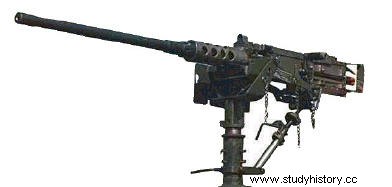Heavy machine gun type

Created 1921
Length of service 1921 still in service with ^most current armed forces
Ammunition .50 BMG (12.7mm )
Mode of action gas borrow
Rate of fire 500 rounds/minute
Velocity 930m/s
Practical range 1800 m
Mass (unloaded) 38.1 kg
Mass (loaded) 55.66 kg (with 105 rounds)
Length 1653mm
Barrel length 1143 mm
Band capacity of 105 rounds
The Browning M2 is a heavy machine gun chambered in 12.7 x 99mm, an ammunition also known as .50 BMG. The design of the M2 dates back to the end of the First World War. It is the fruit of the work of John Moses Browning and shows an unusual longevity. It has a large number of designations and is the main weapon chambering the powerful 12.7mm ammunition which is a NATO standard. Throughout her career, she experienced many times the test of fire, especially during the Second World War. It is still active today in many armies.
The M2 is a derivative of a medium machine gun chambered in 7.62mm. The ammunition was initially developed for anti-aircraft application but the M2 was also adopted for ground use in 1921 by the United States Army as the Model 1921. At that time it was effective against aircraft and against armor.
It knew some improvement in 1932 and was adopted under the name of M2. It was then equipped with a sleeve allowing water cooling. A variant with a heavier air-cooled barrel was developed for airborne applications. The barrel overheated quickly when the machine gun was used by infantry, but the increased barrel mass and increased surface area of the new barrel somewhat compensated for the lack of water cooling. The absence of this one made it possible to lighten the weapon of about twenty kilos and made it simpler to implement. This new variant was called M2 HB, HB being the acronym of Heavy Barrel:heavy barrel in English. Due to the complexity of the operation to dismantle the barrel, an improved system of quick barrel change was created. Versions equipped with lightened 11 kg and 27 kg guns were then developed.
The M2 machine gun offered a significant advantage to the Allies during the Second World War, it was powerful enough to defeat many German light armored vehicles which were equipped with medium machine guns unable to do the same and automatic cannons certainly more powerful than the ammunition of the M2 but also much rarer and much more expensive. Conversely, in air combat, the M2, which was almost exclusively used in American aircraft during the Second World War, lacked power for late-war air combat. While other nations typically implemented at least one or more autocannons aboard their fighters, the United States deployed the M2 almost exclusively for logistical reasons.
The M2 is scaled up from the Browning M1917 to fire the powerful 12.7x99mm ammunition, itself being an enlargement of the .30-06 Springfield. The M2 is today an air-cooled weapon, fed by a strip of cartridges, firing closed breech on the principle of short recoil. The operation of this mechanism is that the barrel and the breech remain united during firing and both recoil. After a reduced stroke, the bolt unlocks and continues its recoil movement while the barrel no longer moves. The bolt opens, ejects the case, pulls the cartridge strip and loads a new cartridge on its return motion. The theoretical rate of fire varies between 450 and 550 rounds per minute. The air version of the Second World War had a rate of fire of 600 to 1200 rounds per minute, while the twin M2s are synchronized and have a rate of 300 rounds only in order to be able to hold longer bursts. These rates of fire are of course theoretical, continuous firing at this rate would lead to the destruction of the barrel after a few thousand shots. In practice, the M2 HB can hardly fire more than 40 rounds per minute when used on the ground.
The practical range of the M2 is 1.8 kilometers when mounted on an M3 tripod (maximum range is 7.4 kilometers). In the configuration intended to be carried and served by the infantry, the M2 weighs 38 kg to which are added a little more than 17 kg for a strip of ammunition of 105 rounds and 20 kg of the M3 tripod. The total weight in order of battle when the M2 is deployed by the infantry therefore amounts to a minimum of 72.62 kg. It has long been equipped with a pair of grips at the rear of the weapon and a V-shaped "butterfly" trigger that must be squeezed with both thumbs to trigger the shot. More recently a new, more conventional trigger has been developed. The weapon can function in automatic or semi-automatic.
The M2 has been designed to be mounted in a large number of configurations. As a result, the belt feed can be done either from the right or the left by changing parts of the mechanisms. This simple operation is done in less than a minute and requires no tools.
During exercises, firing blank bullets requires a specific adapter to maintain sufficient pressure in the barrel to activate the mechanism. This is held at the end of the barrel by three rods attaching to its base.
Grandpa Boyington's favorite machine gun of the hotheads;-)
